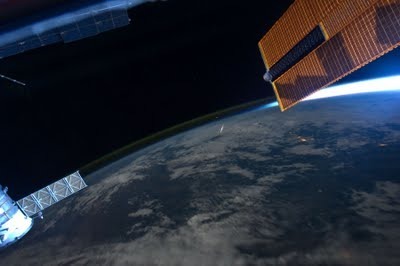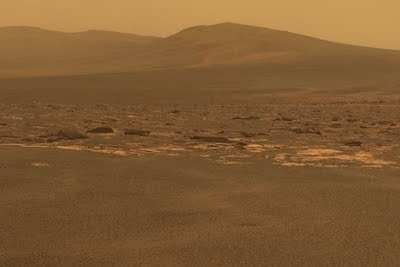Eleanor Arnason's Blog, page 70
September 2, 2011
NASA APOD

With a 3.5 meter diameter mirror, larger than the Hubble Space Telescope, ESA's Herschel Space Observatory explores the Universe at infrared wavelengths. Herschel is named for German-born British astronomer Frederick William Herschel who discovered infrared light over 200 years ago. Herschel's sensitive cameras have combined to deliver this spectacular skyscape looking toward the constellation of the Southern Cross. Spanning some 2 degrees the premier, false-color, far-infrared view captures our galaxy's cold dust clouds in extreme detail, showing a remarkable, connected maze of filaments and star-forming regions. Such observations are intended to unravel mysteries of star formation by surveying broad areas of the galactic plane.
Published on September 02, 2011 05:09
August 26, 2011
More from Glenn Greenwald
Ali Soufan is a long-time FBI agent and interrogator who was at the center of the U.S. government's counter-terrorism activities from 1997 through 2005, and became an outspoken critic of the government's torture program. He has written a book exposing the abuses of the CIA's interrogation program as well as pervasive ineptitude and corruption in the War on Terror. He is, however, encountering a significant problem: the CIA is barring the publication of vast amounts of information in his book including, as Scott Shane details in The New York Times today, many facts that are not remotely secret and others that have been publicly available for years, including ones featured in the 9/11 Report and even in Soufan's own public Congressional testimony...
A spokeswoman for the C.I.A., Jennifer Youngblood, said . . . ."Just because something is in the public domain doesn't mean it's been officially released or declassified by the U.S. government."
Just marvel at the Kafkaesque, authoritarian mentality that produces responses like that: someone can be censored, or even prosecuted and imprisoned, for discussing "classified" information that has long been documented in the public domain...
The Obama DOJ has continuously claimed that victims of the U.S. rendition, torture and eavesdropping programs cannot have their claims litigated in court because what was done to them are "state secrets" -- even when what was done to them has long been publicly known and even formally, publicly investigated and litigated in open court in other countries.
Published on August 26, 2011 09:13
August 25, 2011
Information Wants to be Free. So Do People.
When we ponder the mystery of Barack Obama, we should remember that he has been consistent in two areas: the expansion of war and the expansion of the security state. Guantanamo is still open. People are still being held without trial or charges in Gitmo and elsewhere, apparently forever. Whistle blowers and people who actually believe in free information are savagely prosecuted, as are people who peacefully oppose government policy.
The idea seems to be: shut down opposition, silence those who question the state, at the same time as the Administration expands bombing to Yemen, Pakistan, Libya and Somalia. The CIA cooperates with the NYPD to spy on New York's Muslim community. The FBI raids peace activists in the Midwest.
This is from a Glenn Greenwald post last week:
Greenwald ends his post as follows:

The idea seems to be: shut down opposition, silence those who question the state, at the same time as the Administration expands bombing to Yemen, Pakistan, Libya and Somalia. The CIA cooperates with the NYPD to spy on New York's Muslim community. The FBI raids peace activists in the Midwest.
This is from a Glenn Greenwald post last week:
Several weeks ago, a New York Times article by Noam Cohen examined the case of Aaron Swartz, the 24-year-old copyright reform advocate who was arrested in July, after allegedly downloading academic articles that had been placed behind a paywall, thus making them available for free online. Swartz is now being prosecuted by the DOJ with obscene over-zealousness. Despite not profiting (or trying to profit) in any way -- the motive was making academic discourse available to the world for free -- he's charged with "felony counts including wire fraud, computer fraud, unlawfully obtaining information from a protected computer and recklessly damaging a protected computer" and "could face up to 35 years in prison and $1 million in fines."
The NYT article explored similarities between Swartz and Bradley Manning, another young activist being severely punished for alleged acts of freeing information without any profit to himself; the article quoted me as follows:
For Glenn Greenwald . . . it also makes sense that a young generation would view the Internet in political terms.
"How information is able to be distributed over the Internet, it is the free speech battle of our times," he said in interview. "It can seem a technical, legalistic movement if you don't think about it that way."
He said that point was illustrated by his experience with WikiLeaks -- and by how the Internet became a battleground as the site was attacked by hackers and as large companies tried to isolate WikiLeaks. Looking at that experience and the Swartz case, he said, "clearly the government knows that this is the prime battle, the front line for political control."
Greenwald ends his post as follows:
Economic suffering and anxiety -- and anger over it and the flamboyant prosperity of the elites who caused it -- is only going to worsen. So, too, will the refusal of the Western citizenry to meekly accept their predicament. As that happens, who it is who controls the Internet and the flow of information and communications takes on greater importance. Those who are devoted to preserving the current system of prerogatives certainly know that, and that is what explains this obsession with expanding the Surveillance State and secrecy powers, maintaining control over the dissemination of information, and harshly punishing those who threaten it. That's also why there are few conflicts, if there are any, of greater import than this one.
Published on August 25, 2011 14:06
August 21, 2011
More on Writing
I've been paying attention to how I wrote the current story, currently titled Kormak the Lucky.
It starts with an incident from the Egils saga: as an old man, Egil decides to hide two chests of silver so his son won't inherit them. He's eighty and blind, so he needs help. He takes two slaves with him to carry the silver and they go somewhere and hide the silver. Then Egil kills the slaves, so they can never tell where the silver is hidden. A remarkable achievement for an old, blind man, but hard on the slaves.
I have had an idea -- or image -- for some time. One of the slaves escapes, because an elf opens a door in a cliff and beckons him in. Egil can't see this, of course, and assumes that the slave has fallen in the crevice where the silver has been hidden.
So that is the start of the story: an incident from a saga and an image.
Then I had to figure out the rest of the story. My slave is Irish, as many Icelandic slaves were. I decided I want him to make it home to Ireland. But how? Well, he is underground in Elfland. Maybe there is an underground route to Ireland. So I take him through the country of the light elves, who are the elves of Icelandic folklore, and then through the land of the dark elves, who are mentioned in Snorri Sturlason's Prose Edda, but nowhere else. They may be dwarves, but we don't know for sure. So I can make up everything about them.
At that point, in the land of the dark elves, two things suddenly appeared in the story: one is an magical iron dog, who just walked out of the shadows. I didn't think I needed the dog and tried to get rid of him, but he was too interesting. He felt right. In the end, he stayed.
(I don't believe in talking about my characters as if they have wills of their own. They don't. However, my writing is not entirely a rational process. Sometimes images or ideas seem to come from nowhere, though I assume they come from somewhere in my mind.)
The next thing that came into the story was Volund the Smith, who appears in the Poetic Edda and also in Anglo-Saxon poetry and (I think) medieval German literature. It's a nasty story about violence and revenge. Since Volund is described as an "elf prince" in the Edda, he sort of fits in. I had a character tell it, to explain the iron dog, and then I extended the story of Volund, making it part of my hero's story, which ends in the land of the Irish fey and then -- finally -- in human Ireland.
I'm not going to add more detail. I hope to sell the story. You can read it then.
However, the point -- if there is one -- is that part of the story was rationally worked out; how to get my hero from the land of the Icelandic elves to Ireland was a rational problem: and part of it was intuitive: the original image of the door into Elfland, the iron dog and Volund.
There was no beginning-to-end plot. This particular story was made up as I went along, which means it's a picaresque journey. (If you make stuff up as you go along, you are likely to get a picaresque journey.) Of course, I had to go back and revise earlier parts, so they fit with the later parts.
This is the fourth story I have written that is based on Icelandic sagas or folklore. For some reason, they are all dark stories: three of the four spend a lot of time underground. I think they'd make a nice chapbook, titled The Hidden Folk, which is the Icelandic term for elves, although my stories are also about trolls, the devil and the undead.
It starts with an incident from the Egils saga: as an old man, Egil decides to hide two chests of silver so his son won't inherit them. He's eighty and blind, so he needs help. He takes two slaves with him to carry the silver and they go somewhere and hide the silver. Then Egil kills the slaves, so they can never tell where the silver is hidden. A remarkable achievement for an old, blind man, but hard on the slaves.
I have had an idea -- or image -- for some time. One of the slaves escapes, because an elf opens a door in a cliff and beckons him in. Egil can't see this, of course, and assumes that the slave has fallen in the crevice where the silver has been hidden.
So that is the start of the story: an incident from a saga and an image.
Then I had to figure out the rest of the story. My slave is Irish, as many Icelandic slaves were. I decided I want him to make it home to Ireland. But how? Well, he is underground in Elfland. Maybe there is an underground route to Ireland. So I take him through the country of the light elves, who are the elves of Icelandic folklore, and then through the land of the dark elves, who are mentioned in Snorri Sturlason's Prose Edda, but nowhere else. They may be dwarves, but we don't know for sure. So I can make up everything about them.
At that point, in the land of the dark elves, two things suddenly appeared in the story: one is an magical iron dog, who just walked out of the shadows. I didn't think I needed the dog and tried to get rid of him, but he was too interesting. He felt right. In the end, he stayed.
(I don't believe in talking about my characters as if they have wills of their own. They don't. However, my writing is not entirely a rational process. Sometimes images or ideas seem to come from nowhere, though I assume they come from somewhere in my mind.)
The next thing that came into the story was Volund the Smith, who appears in the Poetic Edda and also in Anglo-Saxon poetry and (I think) medieval German literature. It's a nasty story about violence and revenge. Since Volund is described as an "elf prince" in the Edda, he sort of fits in. I had a character tell it, to explain the iron dog, and then I extended the story of Volund, making it part of my hero's story, which ends in the land of the Irish fey and then -- finally -- in human Ireland.
I'm not going to add more detail. I hope to sell the story. You can read it then.
However, the point -- if there is one -- is that part of the story was rationally worked out; how to get my hero from the land of the Icelandic elves to Ireland was a rational problem: and part of it was intuitive: the original image of the door into Elfland, the iron dog and Volund.
There was no beginning-to-end plot. This particular story was made up as I went along, which means it's a picaresque journey. (If you make stuff up as you go along, you are likely to get a picaresque journey.) Of course, I had to go back and revise earlier parts, so they fit with the later parts.
This is the fourth story I have written that is based on Icelandic sagas or folklore. For some reason, they are all dark stories: three of the four spend a lot of time underground. I think they'd make a nice chapbook, titled The Hidden Folk, which is the Icelandic term for elves, although my stories are also about trolls, the devil and the undead.
Published on August 21, 2011 07:39
Writing
I've trying to pay attention to how I write. It turns out I spend a lot more time writing than I thought, if I add in research and mulling. When I exercise, I spend 30 minutes walking the track at the Y, since I find this less boring than a treadmill. While I walk, I think about the story I'm currently writing. I also think about the current story while doing anything that isn't occupying -- riding a bus, in bed at the edge of sleep.
Yesterday, I read the Havamal in a bad online translation, looking for a quote I could use in a story. I didn't find it. I am now going to read my at-home, much better translation and see if I missed something. (I just checked. I can't find what I want. Maybe I need to look at Auden's translation of the Poetic Edda.)
This is writing work, though I am not putting words on paper. I have to remind myself of this. Otherwise, I think I barely write at all.
I can write more and should, if I am going to finish all the projects I have lined up. But I also have to allow for the mulling and research time.
Yesterday, I read the Havamal in a bad online translation, looking for a quote I could use in a story. I didn't find it. I am now going to read my at-home, much better translation and see if I missed something. (I just checked. I can't find what I want. Maybe I need to look at Auden's translation of the Poetic Edda.)
This is writing work, though I am not putting words on paper. I have to remind myself of this. Otherwise, I think I barely write at all.
I can write more and should, if I am going to finish all the projects I have lined up. But I also have to allow for the mulling and research time.
Published on August 21, 2011 07:19
NASA APOD

The dust sculptures of the Eagle Nebula are evaporating. As powerful starlight whittles away these cool cosmic mountains, the statuesque pillars that remain might be imagined as mythical beasts. Pictured above is one of several striking dust pillars of the Eagle Nebula that might be described as a gigantic alien fairy. This fairy, however, is ten light years tall and spews radiation much hotter than common fire. The greater Eagle Nebula, M16, is actually a giant evaporating shell of gas and dust inside of which is a growing cavity filled with a spectacular stellar nursery currently forming an open cluster of stars. The above image in scientifically re-assigned colors was released in 2005 as part of the fifteenth anniversary celebration of the launch of the Hubble Space Telescope.
Published on August 21, 2011 07:16
August 17, 2011
NASA APOD

Denizens of planet Earth watched this year's Perseid meteor shower by looking up into the moonlit night sky. But this remarkable view captured by astronaut Ron Garan looks down on a Perseid meteor. From Garan's perspective onboard the International Space Station orbiting at an altitude of about 380 kilometers, the Perseid meteors streak below, swept up dust left from comet Swift-Tuttle heated to incandescence. The glowing comet dust grains are traveling at about 60 kilometers per second through the denser atmosphere around 100 kilometers above Earth's surface. In this case, the foreshortened meteor flash is right of frame center, below the curving limb of the Earth and a layer of greenish airglow. Out of the frame, the Sun is on the horizon beyond one of the station's solar panel arrays at the upper right. Seen above the meteor near the horizon is bright star Arcturus and a star field that includes the constellations Bootes and Corona Borealis. The image was recorded on August 13 while the space station orbited above an area of China approximately 400 kilometers to the northwest of Beijing.
I want this photo for the cover of a book...
Published on August 17, 2011 08:33
August 15, 2011
What If?
There's been discussion on the Book View Cafe Blog: what if you had an adequate income from a patron, so money was not a consideration. What would you write? Would you write at all?
One of the comments, which I really liked, came from Nancy Jane Moore. She said she'd love to have the time to write -- and do all the things that nourish writing. Reading, thinking, spending time with music and art.
I wrote:

One of the comments, which I really liked, came from Nancy Jane Moore. She said she'd love to have the time to write -- and do all the things that nourish writing. Reading, thinking, spending time with music and art.
I wrote:
I like Nancy Jane Moore's comment. It reminds me of all the things I need to do besides write: concerts, museums, walks, reading, thinking. Something else to structure into my life, now that I have time.
I spent most of my working life working part time or saving money and quitting to write full time, then getting another job when the money ran out. I knew I wanted to write, and I knew writing was financially risky. It seemed smarter to have a day job and write what I wanted, when I wanted. It meant that I never had enough writing time, but it enabled me to walk away from contracts I didn't like and to take all the time necessary to do a good job.
It's unsettling to know I may never have another day job. But I am writing more, and I think that's my priority right now.
Why to I write? Because I always have, since childhood; and I like the attention; and I think making art is an important job, worth doing; and because it helps me deal with a difficult world.
Published on August 15, 2011 12:23
There's been discussion on the Book View Cafe Blog: what ...
There's been discussion on the Book View Cafe Blog: what if you had an adequate income from a patron or whatever, so money was not a consideration. What would you write? Would you write at all?
One of the comments, which I really liked, came from Nancy Jane Moore. She said she'd love to have the time to write -- and do all the things that nourish writing. Reading, thinking, spending time with music and art.
I wrote:

One of the comments, which I really liked, came from Nancy Jane Moore. She said she'd love to have the time to write -- and do all the things that nourish writing. Reading, thinking, spending time with music and art.
I wrote:
I like Nancy Jane Moore's comment. It reminds me of all the things I need to do besides write: concerts, museums, walks, reading, thinking. Something else to structure into my life, now that I have time.
I spent most of my working life working part time or saving money and quitting to write full time, then getting another job when the money ran out. I knew I wanted to write, and I knew writing was financially risky. It seemed smarter to have a day job and write what I wanted, when I wanted. It meant that I never had enough writing time, but it enabled me to walk away from contracts I didn't like and to take all the time necessary to do a good job.
It's unsettling to know I may never have another day job. But I am writing more, and I think that's my priority right now.
Why to I write? Because I always have, since childhood; and I like the attention; and I think making art is an important job, worth doing; and because it helps me deal with a difficult world.
Published on August 15, 2011 12:23
NASA APOD

What can the present-day terrain in and around large Endeavour crater tell us about ancient Mars? Starting three years ago, NASA sent a coffee-table sized robot named Opportunity on a mission rolling across the red planet's Meridiani Planum to find out. Last week, it finally arrived. Expansive Endeavour crater stretches 22 kilometers from rim to rim, making it the largest crater ever visited by a Mars Exploration Rover (MER). It is hypothesized that the impact that created the crater exposed ancient rock that possibly formed under wet conditions, and if so, this rock may yield unique clues to the watery past of Mars. Pictured above, the west rim of Endeavour looms just ahead of the Opportunity rover. Opportunity may well spend the rest of its operational life exploring Endeavour, taking pictures, spinning its wheels, and boring into intriguing rocks.
Published on August 15, 2011 07:53
Eleanor Arnason's Blog
- Eleanor Arnason's profile
- 73 followers
Eleanor Arnason isn't a Goodreads Author
(yet),
but they
do have a blog,
so here are some recent posts imported from
their feed.



